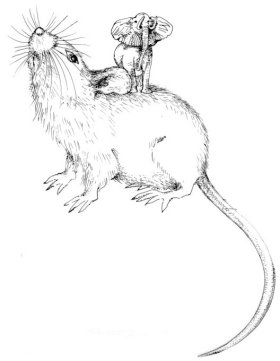A Matter of Size
Today, a matter of size. The University of Houston's College of Engineering presents this series about the machines that make our civilization run, and the people whose ingenuity created them.
I've done a lot of work on the similarity between large and small systems. Years ago I measured the behavior of large objects at low gravity for NASA, by spinning small objects in a centrifuge. That elevated gravity has less effect on small objects because the force of gravity increases as the cube of size. That's why a fly with slightly sticky feet can walk on the ceiling. Scientific modeling is so much fun because it generates surprises like that.
Now an article in the latest New York Times calls my NASA work back to mind. It begins by observing that a mouse eats twenty-two times as much food per ounce of its own weight as an elephant does. Is the elephant that much more efficient? Stop and think about your cats' grocery bill. Ours eat what seems to be a lot of food for their size. It turns out that the amount any animal eats increases only as the three-quarters power of its mass. Diverse as we animals are, that rule is surprisingly reproducible.
A group of scientists at New Mexico's Santa Fe Institute have been studying modeling laws for living things, and they've begun to see through some of the mystery of them. That food/weight rule is only part of the story. Other things scale as well.
The larger the animal, the slower its pulse rate. Blood has to move more slowly in a very large aorta to keep from choking in tiny capillaries. Conduits that carry blood or sap keep subdividing to carry nutrients into all parts of any living thing. The systems that carry sap to plant extremities not only look like our arterial tree; their smallest parts are the same size as ours, because both have to divide down to near-molecular dimensions.
There's more: While any animal's surface area varies as the square of its length, its volume varies as the cube. That means large animals have less surface area for cooling blood, and their metabolic rates have to be slower. And, as we generate more and more such rules, we find they're all connected.
Strength is another scalable quantity. An ant can lift a hundred times its weight. We struggle even to lift just our own weight. That's because, if one animal weighs eight times what another does, it has only four times the cross-sectional area in its limbs. And strength increases with cross-sectional area, not with weight.
Then there's a rule that says the number of species decreases with the mass of their members. Some ten million insect species occupy this Earth; 40,000 birds, fish, and mammals; and that one species of blue whale swims at the peak of the pyramid. Modeling rules among species aren't new, but this one reminds us how our lives are interlaced with those of sharks, ants, and robins.
Change the scale of life and you change its texture. I saw that dramatically at a Women's NBA Championship game last year. With the players scaled down by ten percent in size, the game changed utterly (and, for my money, it changed for the better).
I'm John Lienhard, at the University of Houston, where we're interested in the way inventive minds work.
(Theme music)
Johnson, G., Of Mice and Elephants: A Matter of Size. The New York Times, Science Times, Tuesday, January 12, 1999, pp. D1-D2.
J. H. Lienhard IV and J. H. Lienhard V, A Heat Transfer Textbook. 3rd ed., Cambridge, MA: Phlogiston Press, 2004, Click here for a free copy. Chapter 4.
For more on modeling and scaling laws, see Episode 68.
My Mechanical Engineering colleague, Roger Eichhorn, struck by the need for an encapsulation of these scaling laws in arithmetic form, created the following summary. (Note that the symbol ^ means "raised to the power of." Thus (mass)^1/4 means the fourth root of mass.)
Heart beats per lifetime is constant (around one billion)
Life span is proportional to (mass)^1/4
Pulse rate is proportional to (mass)^-1/4
Metabolic rate is proportional to (mass)^3/4
Strength is proportional to (mass)^2/3
Population density is proportional to (mass)^1/4
Average number of offspring is proportional to (mass)^1/4
Time required to reproduce is proportional to (mass)^1/4
These show all properties except pulse rate increasing with mass. Obviously, these rules are only approximate. For example, little dogs sometimes outlive big ones, and the human species has managed to extend its own life beyond that of a horse. But in the larger overall picture, the rule is pretty accurate.

Image by Maria Szigmond Baca, permission of Peter Gordon